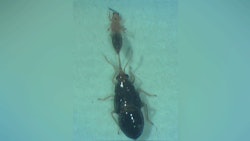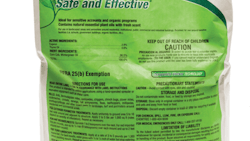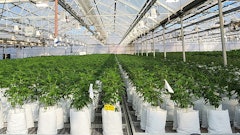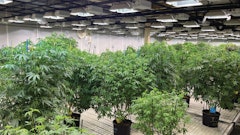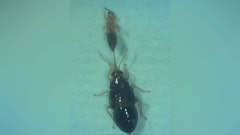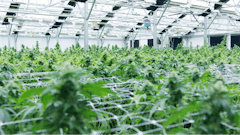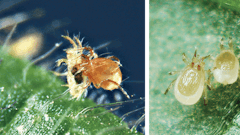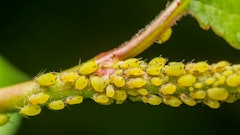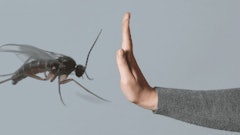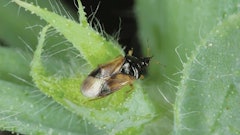
Despite cannabis growers’ stringent protocols and dialed-in integrated pest management (IPM) strategies, aphids, thrips, spider mites and more continue to plague even the most careful cultivation operations.
Here, ahead of his session at Cannabis Conference 2023, Dr. Raymond Cloyd, a professor and extension specialist in horticultural entomology/plant protection in the Department of Entomology at Kansas State University, shares insight into the common pests impacting cannabis cultivation facilities across the country—and what can be done to stop them in their tracks.
Editor’s note: Dr. Raymond Cloyd will speak at Cannabis Conference on the session: “Got Pests? Learn The Best Strategies For Preventing And Mitigating Them For Good,” which will run from 2:30 to 3:20 p.m. on Thursday, Aug. 17. In this session, attendees will walk away with strategies for successful biological control programs to combat the most prevalent pests, as well as various solutions to control pests, including biopesticides and their viability in managing insect and/or mite pests in cannabis. Visit www.CannabisConference.com for more information and to register.
Melissa Schiller: What are common pests that are plaguing cannabis cultivators this year? Are there a few that you’re seeing more than others?
Raymond Cloyd: In indoor production, we typically see the same scenario—aphids, thrips, spider mites, hemp russet mites, root aphids [and] even some root mealy bugs. Those tend to be the standouts. Sometimes we’ll get fungus gnats, but in my dealings with commercial cannabis growers through my consulting gig and my biocontrol program, it’s typically thrips and aphids that they’re mostly dealing with.
MS: How can growers scout out these pests in their crops?
RC: For thrips, we recommend the old sticky cards. For spider mites and aphids, [I recommend] the beat method—that is, you take a white sheet of paper, put it on a board, and then shake the leaves and the branches over that, and you’ll see [the pests] at that point. For root aphids and root mealy bugs, it’s very difficult because they’re in the growing medium. For hemp russet mites, where they’re feeding makes it difficult to detect. In that case, when you see damage, that’s when you need to take action—mostly just roving out the plants—because at that point, it’s too late.
So, [it’s] using the yellow or blue sticky cards for thrips to capture the adults, but also [conducting] visual inspections for aphids and hemp russet and spider mites. These insects don’t have chewing mouth parts, so for thrips, you’re going to see deformation of leaves. Spider mites, you’ll see stippling and speckling—it gives [the plant] a russet or dirty appearance. Aphids, you might see a curling or distortion of leaves. And then root mealy bugs and root aphids, they’re going to cause the plant to be stunted and maybe wilting because they’re feeding on the roots. So, the symptomology or the visible symptoms that are exhibited during feeding will vary depending on the insect. And sometimes you’ll have more than one [insect] simultaneously.
MS: What are some strategies for successful biological control programs to combat some of these prevalent pests?
RC: By the time you see the damage, it’s too late. That’s why a biological control program is proactive—that is, you get your plants in the greenhouse and you start making releases. By the time you see the damage, the populations are already established. At that point, you can’t use biologicals.
The producers I’ve worked with and the one I was [visiting] in St. Louis a couple months ago, I said, when you get your plants into the greenhouse, make the release of the predatory mites because you know you’re going to get problems, but at least you have your biologicals there ahead of the game, not after the fact when you begin seeing damage. Once you see damage, biological control becomes a non-option at that point.
MS: What are some other solutions to control pests, whether it be biopesticides or other tools?
RC: Sanitation is critical, [as well as] keeping the plants healthy. Biopesticides are an option, but they do have some limitations, which I’ll mention at the [conference]. Their efficacy varies because some of these materials are living organisms like fungi that require specific relative humidities and temperatures, and if you’re not within that range, they’re not going to perform well—that is, they’re not going to manage the insect or mite populations.
Routine scouting is critical because the cannabis growers just don’t have the options, and I’m not a proponent of spraying oil. You don’t know what’s going to happen to the plant. So, to me, scouting, sanitation [and] cleanliness [are the best options]. I’ve been to these operations, and they really have a rigorous sanitary program, and of course that’s going to show up in fewer and fewer pest problems. By implementing a sound, sanitary practice—washing hands, wearing gloves, maybe some high-pressure or negative-pressure areas where you enter and there’s a vacuum or it pushes the air out—those are some means to eliminate or avoid problems.
MS: What is one thing you’d like attendees to take back to their business after attending your session this year?
RC: Like in all my talks, I want them to know that there are sources [and] there are people out there, that can help them—such as myself. So, know that you have a source of contact, but also be diligent in understanding the production system and understanding the ecology of insects so that you can avoid problems with them, such as the environmental temperatures [that they thrive in]. Also, scout vigorously. I call it an aggressive scouting program. When dealing with this plant protection, when your bud is in bloom and it’s sticky and you have pest problems, you’ve lost the game. So, in working with the growers in Colorado and across the country, when they implement these aggressive scouting programs, they don’t have to deal with the pests on the back end.
It really isn’t even prevention. It’s being very proactive in scouting and implementing a biocontrol program, a sanitation program, a phytosanitation program. It’s a lot of work, but like I tell my students, the more you do in the front end, the less problems you’re going to have on the back end. And when you start having problems at the back end, that starts cutting into yield and profits.
Editor’s note: This interview has been edited for style, length and clarity.
Join us this year at the Paris Las Vegas Hotel & Casino for Cannabis Conference, the leading education and expo event for plant-touching businesses.










